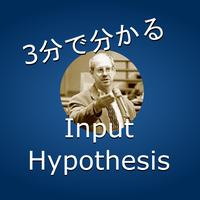Monitor Hypothesis 監視 仮説 に ついて
monitor|hypothesis|かんし|かせつ||
monitor|monitoring assumption|monitoring|hypothesis (1)||
Monitor Hypothesis About the Monitor Hypothesis
监控器假说 关于监控器假说
では 次の 監視 仮説 に ついて 見て いきます。
|つぎの|かんし|かせつ|||みて|
||monitoring|hypothesis (1)||||
We will now look at the next surveillance hypothesis.
監視 仮説 と は 何かと 言う と 学習 、すなわち 意識 的な 学習 の 効果 と いう の は 自己 監視 ・モニタリング と 自己 修正 ・エディティング の 効果 のみ です よ と いう こと を 言ってる 訳 です。
かんし|かせつ|||なにかと|いう||がくしゅう||いしき|てきな|がくしゅう||こうか|||||じこ|かんし|||じこ|しゅうせい|||こうか||||||||いってる|やく|
monitoring|hypothesis (1)|||in various ways|||learning|that is|consciousness|conscious|||effect||||||self-monitoring|monitoring|||self-correction|editing||effect||||||||saying||
The monitoring hypothesis says that learning, that is, the effect of conscious learning, is only the effect of self-monitoring and self-correction/editing.
これ を 逆に 言う と 、学習 で は 言葉 を 使える よう に は なりません よ と いう こと に なります。
||ぎゃくに|いう||がくしゅう|||ことば||つかえる||||||||||
||conversely|||||||||||||you|||||
To put it the other way around, learning doesn't make you able to use words.
それでは 四 つ 目 の インプット 仮説 に ついて 見て いきましょう。
|よっ||め|||かせつ|||みて|
||||||hypothesis (1)||||
Now let's look at the fourth input hypothesis.
この インプット 仮説 と いう の は 、この スティーブン ・クラッシェン の 理論 に おける 中心 的な 仮説 に なる ん です けれども 、言葉 の 習得 と いう の は 理解 可能な インプット に よって のみ 起こる と。
||かせつ|||||||||りろん|||ちゅうしん|てきな|かせつ||||||ことば||しゅうとく|||||りかい|かのうな|||||おこる|
||||||||Stephen|||theory|||||||||||||||||||||||||
The input hypothesis is the central hypothesis of Stephen Krashen's theory, which states that language acquisition occurs only through comprehensible input.
即 ち 無意識 的な 習得 と いう もの は この 理解 可能な インプット と いう もの が 大事な んだ と いう 風 に 言って いる わけです。
そく||むいしき|てきな|しゅうとく||||||りかい|かのうな||||||だいじな||||かぜ||いって||
|||||||||||understandable|input|||||||||||||
In other words, unconscious learning is saying that this comprehensible input is important.
即 ち 理解 可能な インプット (i + 1)の インプット を 大量に 行う こと が 言葉 を 習得 する ため の 唯一 の 方法 である と いう 風 に 言った 訳 です。
そく||りかい|かのうな||||||たいりょうに|おこなう|||ことば||しゅうとく||||ゆいいつ||ほうほう||||かぜ||いった|やく|
immediately|||||||||a lot|to perform|||||acquisition||||||||||||||
In other words, the only way to learn a language is to produce a large amount of comprehensible input (i + 1).
では 、この i + 1 と いう の は どういう こと か と いう と 、自分 自身 が 簡単に 分かる レベル から 少し だけ 難しい レベル 、パーセンテージ で いう と 九十五 パーセント から 九十八 パーセント ぐらい の 理解 できる 教材 を 使う と いう こと が 言葉 を 習得 する 上 で 最も 効果 が 高い と いう こと を 言ってる 訳 です ね。
|||||||||||||じぶん|じしん||かんたんに|わかる|れべる||すこし||むずかしい|れべる|||||きゅうじゅうご|ぱーせんと||きゅうじゅうはち|ぱーせんと|||りかい||きょうざい||つかう|||||ことば||しゅうとく||うえ||もっとも|こうか||たかい|||||いってる|やく||
||||||||||||||||||||||||||||ninety-five|||ninety-eight||||||||||||||||||||||||||||||
The i + 1 means that the most effective way to learn a language is to use materials that you can understand at a level that is between easy and slightly difficult for you, or 95% to 98% of the time. That's right.
簡単な もの を 大量に インプット する。
かんたんな|||たいりょうに||
Input a large amount of simple materials.
これ が 言葉 を 習得 する 唯一 の 方法 な のだ と いう 風 に クラッシェン は 結論付けて います。
||ことば||しゅうとく||ゆいいつ||ほうほう|||||かぜ||||けつろんづけて|
|||||||||||||||||concludes|
This is the only way to learn a language, Krashen concludes.

